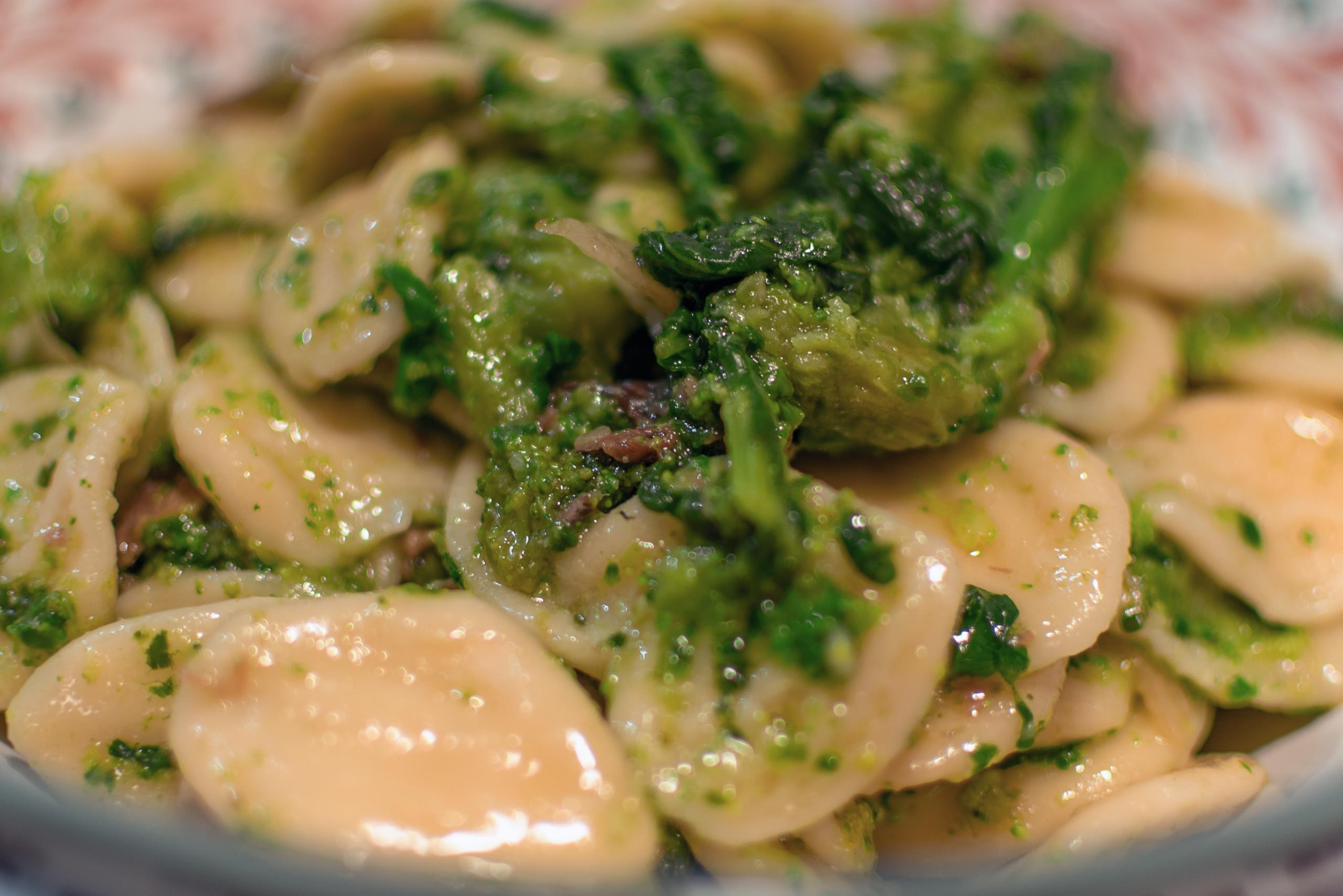7 recipes to take your taste buds to Puglia

We craft our itineraries with the sole purpose of revealing to you the very best of Puglia. And that includes food too! So if you come on holiday to this beautiful region, delights – including the culinary kind – await at every turn.
In this article, we share some of our favorite recipes from the stops included in our self-drive tours. Try adding them to your cooking roster, you’ll be thanking us later!
Table of contents
> From Bari: orecchiette con le cime di rapa
> From Polignano: caffè speciale
> From Alberobello: carciofi sott’olio
> From Grottaglie: li puddíchi cu llu pépi
> From Gallipoli: scapece
> From Lecce: ciceri e tria
> From Otranto: riso, patate e cozze
From Bari: orecchiette con le cime di rapa
If you ask someone from Italy what’s Puglia’s most famous dish, the answer will be, 90 percent of the time, orecchiette con le cime di rapa. Those who grew up here may disagree, as this iconic dish is local to Bari and it’s not representative of Puglia in general. But let’s leave local rivalries behind, shall we? And let’s see instead how to prepare this delicious pasta.
Just a couple of notes first:
- You could make orecchiette pasta from scratch, but that’s not for the fainthearted, so if you haven’t taken a cooking class before (like those included in our tours), we recommend you buy them ready-made.
- Next, let’s talk cime di rapa, not to be confused with broccoli. What you need for this recipe is Broccoli rabe or rapini.
The recipe:
Place a pot with water on the stove and while you wait for it to boil, clean and wash the Broccoli rabe. When the water starts boiling, put the turnip greens and let them boil for exactly two minutes, then put the pasta in.
Pour some oil in a pan to fry the garlic and chili pepper. After about 30 seconds, add the anchovies and, with the help of a wooden spoon, try to roughly chop them up.
At this point, when the Broccoli rabe and pasta are cooked, drain everything. Now you can either put the pasta and vegetables back into the pot, add the oil with garlic, chili pepper and anchovies and mix well or, if you have a very large pan, you can pour the pasta and greens directly into the pan and stir with the help of a wooden spoon.
Whatever you decide, stir well, remove the cloves of garlic and serve!
From Polignano: caffè speciale
This special coffee from Polignano a Mare, a seaside town with one of the best beaches in Puglia, combines coffee and lemon, a curious pair that strangely works. It’s prepared with coffee, sugar, lemon peel, cream and amaretto: these are the 5 ingredients that make it unique.

From Alberobello: carciofi sott’olio
The world-famous trulli aren’t the only reason for visiting Alberobello. Here you can try Pugliese traditional cuisine at its best. This local recipe for marinated artichokes provides you with a delicious way to make them last a little bit longer.
The recipe:
Clean the artichokes until you reach the tenderest part; put them in a container with water and pieces of lemon and leave them there for about 30 minutes. Then boil the artichokes with salt and vinegar. Once ready, drain and let cool. Put them in glass jars, arrange them in layers and add chopped garlic, parsley, pepper or chili pepper. Cover with extra virgin olive oil. Close the jars with a sealed lid and store them for 15 days, after which you can go ahead and open them!
From Grottaglie: li puddíchi cu llu pépi
This recipe hails from Grottaglie, a town famous for its ceramics and pottery-making heritage. It’s usually prepared for Easter celebrations and it is doughnut-shaped.
The recipe:
An hour before you start to prepare the doughnuts, pour some olive oil in a saucepan and then add lemon peel, when it’s cooked it means that the oil is ready and should be removed from the heat, then wait for the oil to cool down. Place the flour (1 kg) on a board, make a well in the middle of the flour and pour in the oil, yeast and salt then start kneading. Add the black pepper and continue to mix with lukewarm water until the mass is soft and compact. At this point, prepare strips of medium size, form the doughnuts and place them on a wooden board to rest under a cotton tablecloth. When they puffed, brush the top of the doughnuts with egg yolk. Bake them in a hot oven and take them out when they are golden brown.
From Gallipoli: scapece
Known as la città bella, Gallipoli had to constantly fend off invaders throughout its history. This meant that this seaside town, which heavily relied on fishing, was often under siege and had to come up with food that could last for days on end. Enter scapece, a way to preserve raw protein, mainly fish, that was fried, dipped in breadcrumbs and then marinated in vinegar and saffron.
From Lecce: ciceri e tria
This is an ancient recipe, so much so that even the poet Horace mentions it as early as 35 BC! The name comprises of tria, a word derived from the Arabic ittrya meaning fried (or dry) pasta, and ciceri, meaning chickpeas. This recipe requires that you make fresh pasta from scratch following the local variant, without eggs and with semolina flour, water and extra virgin olive oil.
The recipe:
Soak the chickpeas overnight and then slow-cook them in a pot with chopped onion, garlic, chili, celery and carrots, add vegetable broth from time to time to keep them moist.
For the pasta, prepare the dough (two-thirds of 00 flour, one-third of durum wheat flour or barley flour and water), knead as you would any other pasta but then cut it to obtain tagliatelle, a couple of centimeters wide. The resemblance to pasta scraps is what makes this pasta unique. Boil half of the pasta and fry the rest in extra virgin olive oil.
Add the boiled pasta to the chickpeas next, mix well, then add the fried pasta. Finish with lots of pepper!
From Otranto: riso, patate e cozze
The combination of these three ingredients, rice, potatoes and mussels, is a staple of Pugliese cuisine, Salento in particular. Here, this layered dish takes the name of taieddha, a nod to the pan used to prepare it.
The recipe:
Chop garlic and parsley. Wash mussels, then place them in a pan, adding part of the chopped mixture, to let them open over the heat. Do not throw away the water you used to cook them in, as it will be used to flavor your taieddha.
Grease a baking tin with oil, preferably with high edges and at least 30 cm in diameter. Arrange the sliced onion on the bottom, then the chopped tomatoes and a bit of pecorino.
Cover with a layer of potatoes, cut wide and thin, and raw rice (wash it first). Place the mussels without the shell on top of it, followed by the chopped tomatoes and potatoes. Add more pecorino cheese, pepper, breadcrumbs and sprinkle with olive oil.
Finally, slowly pour the cooking water of the mussels, until you completely cover the contents of the pan.
Preheat the oven and bake at 180° for about 45 minutes. Remove the dish from the oven when the surface begins to crisp.
